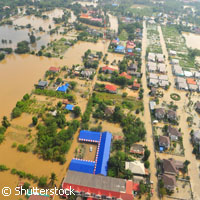All 27 Member States in on geohazards project
The impact of geohazards such as flooding and volcanoes on our everyday lives will soon be better understood, thanks to a new EU-funded project involving all 27 Member States, which has just got up and running. 'PANGEO' (Enabling access to geological information in support of Global Monitoring for Environment & Security (GMES)), which received funding to the tune of EUR 2.5 million under the 'Space' Thematic area of the Seventh Framework Programme (FP7), will work towards the pooling of European geological data to form an information portal for public policymakers. Led by satellite mapping specialists Fugro NPA in the United Kingdom, the PANGEO project kicked off in February 2011; the next 3 years will see contributions from and cooperation between 37 partners across the entire European Union. The ultimate aim of the project is to create a free, online geohazard information service, or 'Geohazard Data Layer', supported by a Geohazard Summary for 52 of the largest towns listed in the GMES Land Theme's Urban Atlas involving all 27 Member States. The 52 towns make up 13?% of the EU's population; 2 towns from each Member State are included, bar Cyprus and Luxembourg that will contribute with 1 town each. All this data brought together spatially will enable users to view the often complex relationships between the many rocks and deposits found across Europe's varied terrain. Such an open-access information service will enable policymakers, regulators and citizens alike to systematically access information on geohazards about each of these 52 towns, as well as explanatory data about geohazards and the different socioeconomic impacts they can have. The datasets will be made accessible and useable via a distributed web-map system. PANGEO is the latest in a series of projects in support of GMES, an EU-led initiative coordinated by the European Commission in partnership with the European Space Agency, the European Environment Agency and Member States through a series of projects funded under FP7. GMES comprises a complex set of systems which collect data from multiple sources (earth observation satellites and in situ sensors such as ground stations, and airborne and seaborne sensors), to help us understand how our planet and its climate are changing. 'We want to bring about an overall improvement in general knowledge about, and access to, information on geohazards,' says project coordinator Ren Capes from Fugro NPA. 'There are already GMES services for the sea, the air and land surfaces, but not for what's beneath the land - the geology. PANGEO helps to bring geology into GMES.' Data about how society is affected by quarrying, volcanoes, flooding, radon, underground aquifers, subsidence/landslides/slope stability and pollution, can be indispensible for making good risk-management decisions. Therefore, the key users of the future PANGEO web portal are expected to be first and foremost local authority planners and regulators concerned with managing development risk. Other expected users are policymakers concerned with assessing and comparing European geological risk, and national geological surveys and geo-science institutes that need to collect geohazard data for public benefit. The project also brings information previously reserved for specialists into the public domain for all citizens to access. The PANGEO portal will be fully compliant with the INSPIRE Directive, which came into force on 15 May 2007 and will be implemented in various stages, with full implementation required by 2019. The directive aims to create an EU spatial data infrastructure so that spatial information can be shared among public sector organisations and the public. The philosophy behind the European spatial data infrastructure is very much 'policymaking sans frontiers'. Europe has been blighted by many devastating floods in recent years, most recently when central Europe was severely flooded in summer 2010. Poland was the most severely affected, as were the Czech Republic, Germany, Hungary, Austria and Slovakia. Ren Capes emphasises the importance of PANGEO for Europe. 'Geohazards cost the EU billions of euros per year. PANGEO is not a panacea but can certainly help to alleviate some of these huge losses by facilitating better-informed decisions. PANGEO also exploits specific EU expertise in Earth observation InSAR technology.'For more information, please visit:Fugro NPAhttp://www.fugronpa.com/
Countries
Austria, Belgium, Bulgaria, Cyprus, Czechia, Germany, Denmark, Estonia, Greece, Spain, Finland, France, Hungary, Ireland, Italy, Lithuania, Luxembourg, Latvia, Malta, Netherlands, Poland, Portugal, Romania, Sweden, Slovenia, Slovakia, United Kingdom



